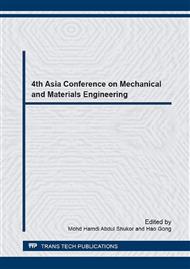p.105
p.110
p.114
p.119
p.124
p.128
p.132
p.136
p.140
Metallography & Bulk Hardness of Artificially Aged Al6061-B4C-SiC Stir Cast Hybrid Composites
Abstract:
Present investigation focusses on combined effect of B4C and SiC on the improvement in hardness with an average size of 35-40μm on Al6061 hybrid composite. Composites are produced by stir casting process. The effect of artificial aging treatment with different aging temperatures of 100, 150 and 200OC on the improvement in hardness is also investigated. Optical micrographs and Brinell hardness number have been discussed. An attempt is made to find out the intermetallic phase responsible for strengthening by Transmission Electron Microscopy. Due to positive response to age hardening treatment there is an improvement in the mechanical properties of Al6061 alloy & its hybrid composite. The aging kinetics is more accelerated in case of hybrid composites as compared to unreinforced Al6061 alloy because of presence of reinforcement particulate, which act as nucleation site for precipitation. Artificially aged at 100OC shows improvement in hardness by 120-220% due to the precipitation of secondary solute rich phase of alloying elements as compared Al6061 alloy.
Info:
Periodical:
Pages:
140-143
Citation:
Online since:
November 2016
Keywords:
Price:
Сopyright:
© 2017 Trans Tech Publications Ltd. All Rights Reserved
Share:
Citation:


